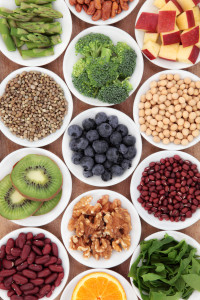Weekly highlights, new giveaways, and BONUS workouts!
Subscribe to our email list by using the red box at the top of this page.
Subscribe to our email list by using the red box at the top of this page.

There are a number of “buzz words” in the health and fitness industry – “HIIT”, “AMRAP”, “superset”, “clean eating”, and “carb cycling” to name just a few. Among these there’s one that tends to regularly make and appearance and that (in my experience) not many people understand. Today we’re talking all about “macros” – what they are, why they’re important, and why you should care about them. Looking to lose weight? To tone better muscle? To get in better shape? Keep reading and you just might find the answers you’re looking for…
 What are macros? “Macros” is short for “macronutrients”. Macronutrients are large nutrients that supply our bodies with energy (calories). They are specifically carbohydrates, fat, and protein. These are found in varying amounts and percentages in pretty much all the food we eat and are typically measured in grams. Each macronutrient provides us with a certain number of calories per gram as follows:
What are macros? “Macros” is short for “macronutrients”. Macronutrients are large nutrients that supply our bodies with energy (calories). They are specifically carbohydrates, fat, and protein. These are found in varying amounts and percentages in pretty much all the food we eat and are typically measured in grams. Each macronutrient provides us with a certain number of calories per gram as follows:
Fat – 9 calories per gram (examples include avocados, nuts, cheese, and virgin oils)
Protein – 4 calories per gram (examples include fish, chicken, eggs, and protein drinks/bars)
Carbohydrates – 4 calories per gram (examples include quinoa, oats, bananas and sweet potatoes)
Why are they important? Monitoring your macros is a valuable way to evaluate the quality of the food you’re eating and analyze your food consumption to better line up with your goals. Most people who read this site have a goal to lose a little weight (at least to tone and tighten!). Eating less calories than you burn is going to help you lose weight (read more about that here), however eating the right calories will help you to lose the right weight; or in other words paying attention to your macros helps you burn more fat while maintaining valuable muscle mass. There’s a pretty big difference between 100 calories of eggs (protein and fat) vs eating 100 calories of doughnut (carbs).
What is my optimal macro intake? Keep in mind every person who asks me this question is going to get a different answer from me. The answer depends on your age, gender, weight, muscle mass, BMI, and activity level to name just a few things. However, the most important factors in answering the “how many macros should I consume” question is this – What are your goals?? If you want to lose weight that’s one thing, but what about those who want to lose fat and maintain muscle mass? What about those who want to gain a large amount of muscle mass? Your macro intake is going to be VERY different depending on what your personal fitness goals may be. Click Here for a great macro calculator which is also free that you can customize to your individual needs.
How should I track my macros? There are amazing people in this world who are gifted enough to make our lives easier. There are apps you can put on your phone where you track the foods you eat and the app will generate all these calculations for you. The one I use daily and that gets my highest recommendation is My Fitness Pal (.com and app). This is probably the easiest way I have found to track your macros throughout the day. You simply input the food and quantity you consume throughout the day and it does the rest for you. It’s a simple way to track total nutrient consumption, not just macros.
If, however, you are a little more old school and prefer to calculate things with a pencil and paper: you take the fat, protein, and carb grams in your foods and multiply it by the number of servings you ate. At the end of the day you’ll have three totals – total grams of fats, carbs, and protein. You can then use these numbers to determine what you’re consuming too much of, too little of, and where your diet is just right.
Finally, it’s crucial that you remember that what we put into our bodies is only a part of the fitness/weight loss equation. The energy we expend (exercise) is the second crucial piece of the puzzle in helping your fitness progression. A healthy, balanced diet combined with a consistent exercise routine consisting of cardio and strength training is absolutely the fastest, most effective way for you to achieve your fitness goals.
Looking for some delicious, healthy recipes that are sure to get your eating off on the right track? Here are a few of my favorites on Tone-and-Tighten.com:
Disclosure: I am a doctor of physical therapy; not a nutritionist. I’ve learned a lot about macronutrients over the years, but by no means am I an expert in this field. The contents of this post are strictly meant for information purposes only. If you’re interested in learning more about nutrition, macros, and healthy eating, I would encourage you to consult with a registered dietician or nutritionist to see what is the healthiest way to make that happen for your individual needs.
Make it happen,
Jared




